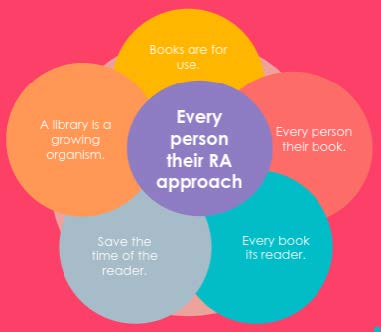Readers Advisory Reimagined

Embedding Readers Advisory
How do we create sustainable RA practices that empower staff and embed Readers’ Advisory fully into libraries? Even pre-pandemic, libraries were not only about lending books. Libraries are creative spaces, not only for individuals, but also teams and communities. They are idea incubators and learning hubs. They open doors for curious minds, and they help our
communities find the fuel and the spark to ideas and opportunities. Most of all, libraries are the entry points to the digital world. They are the way for everyone to embrace technology and seek to close the digital divide.
In 2015, while I was earning my MLIS degree from the University of Washington iSchool, I enrolled in a great readers’ advisory course for adult genres. Basically, every two weeks, the course covered a particular genre for adult readers. During the module focusing on graphic novels, I happened to cross paths with one of my colleagues at Multnomah County Library, who was then on the My Librarian team. I asked them if they had any graphic novel recommendations for me, and they obligingly launched into my first readers’ advisory interview in which I was the advisee, rather than the adviser. I ended up being really surprised by two aspects of our conversation: one was how surprisingly difficult it actually was for me to
articulate my own reading preferences.
Here is a sample of how it transpired:
Them: “Do you like plot-driven books or character-driven books?”
Me: “Ummm. . .“
Them: “Well, do you like books with strong female protagonists?”
Me: “Sometimes. . .? But sometimes I kind of find them annoying, too. . .?”
Them: [scratching head bemusedly] “I see. . . .”
The other aspect that I found both remarkable and surprising was how intimate the interaction felt to me. It seemed as if I was allowing them to enter into my own interior monologue – as a benign and helpful observer, but it still felt as if I was pulling back a curtain for them that I didn’t even realize existed.
Both the course and talking through the readers’ advisory interview taught me a great deal about the level of trust surrounding this process, and how those who participate in readers’ advisory must earn and sustain that trust.
Readers’ advisory provides us with a crucial opportunity to forge a space for patrons to become fully themselves as readers. In essence, readers’ advisory provides the opportunity to communicate, “It’s safe here. Let’s
explore and discover together.” It is a transformational moment, not a transactional one. A time to create the feeling that your next book is just around the corner – even more perfect than can be imagined.
As Ali Smith writes in her 2015 work, Public Library and Other Stories,
“This book wishes you well. It wishes you the world. It wishes you somewhere warm, safe, well-lit, thoughtful, free, wide open to everybody, where you’ll be surrounded by books and all the different possible ways of reading them. It wishes you fierceness and determination if anyone or anything threatens to take away your access to space, time, thought, knowledge. It wishes you libraries — endless public libraries.”[1]
Through reading, we all expand, and become expansive, as we open ourselves to new worlds and new experiences. Being present at the moment of connection, during the spark of creativity, is the highest privilege that I can imagine – and one of the many facets of my own library love story.
As Nick Hornby describes in the novel High Fidelity, that is the moment when working in public Libraries, for me, becomes “as routinely transcendental” as “a midwife or an artist.”[2] And that’s why I love Readers’ Advisory. And why I believe it deserves a valued place in each and
every library. But how, you may ask? The answer may be closer than you think. . . . Each library’s best resource is its staff. As a whole, library staff members tend to be an exceptionally talented group! Libraries that don’t harness and celebrate the talents of their staff leave an incredible amount of potential on the table. The key to all of this is time and training. Put in the time, put in the training, and form a real commitment with library staff.
We Can Do This By:
Emphasizing openness and authenticity with patrons.
Providing an environment of welcome, acceptance, and trust.
Sharing practical guidance, ongoing maintenance of RA resources, and opportunities to practice
This is how to play and win the Readers’ Advisory Short Game, where you give your staff the training and tools they need to meet their community’s RA needs.
To play and win the Readers’ Advisory LONG Game, you have to prepare for the future. You have to preserve the hard-won knowledge of innovation-on-the-fly and embrace the possibilities even after the current crisis subsides. A lot of RA activities can be pretty easily incorporated into this pandemic-filled world. In my experience during this time, I’ve found that what our customers really, really miss most is the ability to browse. So, how can we integrate, replicate, and adapt the act of “browsing” into the virtual world? In terms of emerging technologies, fields like virtual and augmented reality are changing the way we think about the experience of browsing. Augmented Reality (AR) is a hot topic in the tech world and people are curious about its deployment in various domains, from medicine to gaming. So why not implement it in libraries too and combine digital with reality? AR’s ability to enhance what already exists is what makes it a perfect fit for libraries. One of the future perspectives of library services is a personalized interaction between the system and the user. Whether this is an interactive game projected onto the floor for children to find their next book, digital exhibitions featured on screens, big screens in libraries that can be used to inspire users to find certain books or even a simple display that allows taking a ‘selfie’; libraries can use technology to create a digital experience for the user.
What Makes RA Daunting for Library Staff?
Let’s talk about some of the common barriers to RA that public library staff face. According to a survey developed in 2013 by Library Journal with NoveList and the Readers’ Advisory Research and Trends Committee, the biggest cause of RA anxiety is just keeping up with books and genres. Just the sheer volume of materials published can be really overwhelming, Nearly as many respondents also noted their discomfort with unfamiliar genres. In addition, the majority of respondents felt good about their adult RA work, but when it came to advising children and young adults, significantly fewer respondents thought that their abilities were up to par. Circumstances and frustrations like these are completely understandable. These concerns are really even more applicable with each passing year, in which the “book world” now includes even more publication sources and formats to keep up with. Overcoming this particular barrier is where RA tools and resources can really make a difference. Resources like understanding how to apply factors like Nancy Pearl’s four doorways, or NoveList appeal terms and themes, provide a practical basis for recommending titles — even in genres which might not be the staff member’s absolute fave, or with which the staff member might not be familiar.
Is It the Fear of Getting it Wrong?
Library staff might find RA intimidating because they really don’t want to recommend a book that a patron absolutely hates! There can also be the fear of a “trickle-down” effect, where they may be apprehensive that a negative RA experience could damage the patron’s relationship with the library itself or with library staff. And there’s a definite vulnerability and an
underlying trust that comes with RA territory. Library staff want to respect that trust, and they definitely don’t want to lose it. To overcome this particular barrier, we can work to change the perception of “failure” in
Readers Advisory, by changing the perception of “success.” Success in RA is the connection and conversation that is established with the patron. Even if a patron doesn’t love a title you recommend, or it doesn’t exactly change their life, it’s pretty likely that they’ll want to tell you all about it. In this way, the RA connection and conversation continue – which actually
translates into “Success!”
Is It Not Having the Right Tools or Training?
Not all library staff thrive at RA in the same way, using the same tools, the same approach, or the same methods of communication. Each of these approaches can be valuable, and each can be supported in different ways, with different tools and opportunities. How do we help – not just to overcome – but to banish these barriers? Well. . . here’s a radical thought. What if . .? We thought of Readers’ Advisory as a Sixth Law of Library Science? We all know and love the Five laws of Library Science as the theory proposed by S. R. Ranganathan in 1931, which detailed the principles of operating a Library System. [3] But what if we re-framed Readers’ Advisory as an essential aspect of operating a library system, and one which is supported by all five of the original “laws of Library Science?” Now, I’m not expecting them to re-write all the Library Science textbooks! But I think it may be worth considering. When considered in this light, each of the five laws of Library Science lends itself effortlessly to the skill, the art, the gift of Readers’ Advisory.
The (Six) Laws of Library Science

Within some library environments, not every staff member can be expected to offer extensive, direct, or possibly even indirect RA, based on their job classifications. However, even within the structure of staff hierarchy, I believe that all library staff can participate, to some extent and at some level, with RA initiatives — even if it’s just a particularly warm referral to another staff member. For those of you who have Clerks, or Pages, or Shelvers, or any classification where RA isn’t expected, these folks are still in the stacks and interacting with your customers. These folks also need to know about your Book Bundles, open RA hours, staff databases – whatever RA options that your system offers. These staff will come across these RA questions with your customers, and so these staff will also need to know how to answer them – warmly, kindly, efficiently, and – to some degree – knowledgeably.
You can empower your staff at all levels – and this is how. Wrap your staff in the armor of RA knowledge and send them forth to conquer any and all RA needs in your community! And if you happen to be a library staff member in one of these classifications, and you’re actually salivating at the thought of having more of a Reader’s Advisory part to play; you’re in the right place. Professional development through engaging fully with topics on your own time, or library associations can provide experience with aspects of library work that you may not be able to find in your current library role.
Citations
- Smith, Ali. Public Library and Other Stories. Anchor Books: New York City; 2015.
- Hornby, Nick. High Fidelity. Riverhead Books: London. 1995.
- Ranganathan, S. R. 1931. The five laws of library science. Madras: Madras Library Association.
Tags: readers advisory, sustainable ra practices












